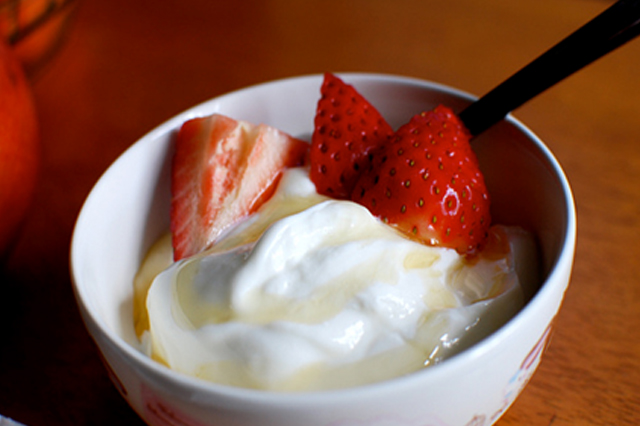

4 cup or greater glass or plastic measuring cup (with a lid is helpful, but not necessary) 
2 Tablespoons live culture yoghurt (You can get it from you local grocery store), or yoghurt culture packet
If you are using a yoghurt culture packet you will need 2 tablespoons milk set aside in a little bowl for use later.
4 cups of milk, the higher the fat content, the better.
6 cup saucepan or pot
Whisk
Piece of an old tee-shirt, cheese cloth, or a tea towel (the kind that is not made out of terry cloth)
alternatively you can use a special greek yoghurt strainer
Optional: 1/4-1/3 cup powdered milk.
Note: These instructions are for 4 cups of milk, but you can make it in larger batches, if you want. 4 cups is just a manageable amount of milk to work with.
Step 1: Scald the milk - Time 3-7 minutes
First you have to scald/pasteurize your milk. This means pouring 4 cups of milk into your saucepan and, over high heat, bring it almost to a boil. This will take about 3 minutes if the milk is at room temperature or 5-7 minutes if it is just out of the fridge. As the milk is just starting to bubble around the edges of the saucepan, remove from the burner. Put a lid on the pan if you want, and then walk away.
You also have the option of adding the powdered milk now, and whisking it in, or doing it later. It does not matter.
Step 2: Let the milk cool - Time 45mins-1hour
Come back periodically over the next hour or so until the pan has cooled down to about 108-115 degrees. You do not need a thermometer for this, you can just use your fingers. When you can hold your fingertips to the side of the pan, for ten seconds without burning them you know it is ready. If you did not add the powdered milk before, you can add it now, or not at all.
Step 3: Add the bacteria - Time 1-2 minutes
If you are using yoghurt culture packets, now you add the packet to the 2 tablespoons and stir and then pour into the saucepan. If using the 2 tablespoons of live culture yoghurt, pour it into the saucepan.
Stir the saucepan of now culture rich milk with a whisk, and then pour back into your glass or plastic cup measure. If your measure cup has a lid, put it on, if not that is also fine.
Step 4: Keep the mixture at 108 degrees - Time 4-12 hours
Turn on the oven light, and turn the oven on to warm. After about 2-4 minutes turn off the oven and then place the measuring cup in the oven. The oven light will produce enough heat to keep your oven pleasantly warm and allow you to peer in at the whole ecosystem you have just created.
Walk away for 4-12 hours. During this time you can use a wireless thermometer that will alert you when the temperature is getting too high or low.
When you wake up from the delightful nap you have just taken, remove the yoghurt from the oven, and turn off the oven light. You can test if the yoghurt is done when you tilt the measuring cup and the yoghurt moves away from the side in one mass.
Step 5: Strain the yoghurt - time 2-4 hours
Now you get to make greek yoghurt.
Take the cloth that you have designated for the straining-tee-shirt, tea towel, or cheese cloth-stretch it over top of a bowl. Keep the cloth in place with several rubberbands stretched around the outside of the bowl. Then pour your yoghurt onto the strainer you have created. Place the bowl and suspended yoghurt into the refrigerator. Let the yoghurt drain for a couple of hours. The longer you let it drain the thicker the yoghurt.
Walk away or read about what to do with your left over whey
You are done!
When the yoghurt has drained long enough, or when you remember that you forgot about it go to the fridge and remove the delicious ready to eat yoghurt.
Remove the rubber bands and gather up the edges of the yoghurt cloth. Avoid submerging the yoghurt in all that delicious whey you have drained off. Put the yoghurt in an air tight container and refrigerate until you want to eat it.